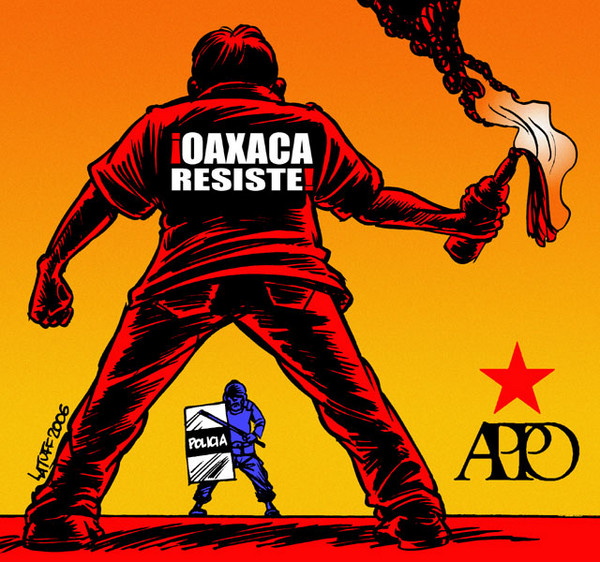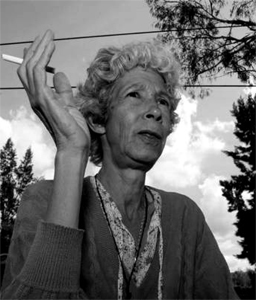
Sixth Declaration of the Zapatistas
Los Dias de Los Maestros

 The People Decide - Nancy Davies
The People Decide - Nancy DaviesDeclaring that “no leader is ever going to solve our problems,” the APPO encouraged the formation of popular assemblies at all levels of society: neighborhoods, street blocks, unions, and towns. The assemblies function by indigenous “uses and customs,” traditional consensus-based governing mechanisms. As with the Zapatistas, leaders govern by obeying the will of the people. Any leader who fails to do so is quickly removed, as has happened to a few APPO members.
Above all, the APPO is a lesson in solidarity. Whereas after four days of struggle in Seattle during the WTO protests some leaders and spokespeople of various organizations publicly denounced one another's tactics, the APPO stands strong and has never taken the focus off of its goals, no matter how ugly the situation has become. The assembly consistently declares its solidarity with Oaxacans in the struggle, its dedication to continue its civil and peaceful struggle, and its condemnation of violent police and paramilitary attacks against them. It also counts every disappeared, murdered, and arrested person and never allows them to be forgotten.
(Kristen Bricker, http://www.leftturn.org/thepeopledecide)

 APPO Communique
APPO Communique
Introduction
The Institutional Revolutionary Party
In order to be able to understand the
“The PRI was founded by Plutarco Elías Calles in 1929 as the National Revolutionary Party (Partido Nacional Revolucionario--PNR), a loose confederation of local political bosses and military strongmen grouped together with labor unions, peasant organizations, and regional political parties. In its early years, it served primarily as a means of organizing and containing the political competition among the leaders of the various revolutionary factions. Calles, operating through the party organization, was able to undermine much of the strength of peasant and labor organizations that affiliated with the party and to weaken the regional military commanders who had operated with great autonomy throughout the 1920s. By 1934 Calles was in control of Mexican politics and government, even after he left the presidency, largely through his manipulation of the PNR.”[2]
The revolution led to about a decade of political instability in
The means taken to “stabilize” the country actually ended up founding the party’s reign through corruption and coercion. The PRI was most notable for being a corporatist party throughout the duration of its reign. The Mexican government ended up drawing major parallels to an “old-boy’s” club. “Corporatism can be defined as a sociopolitical system organized on the basis of functional groups rather than individualism, or one man, one vote; it tends to be top-down, mercantilist, statist, and authoritarian: a mechanism for controlling change and keeping interest groups in line. It is usually anti-liberal, anti-pluralist, and against free enterprise.”[4]
The recent challenging of this ideology has led to the loss of political power for PRI. “The old corporatist Mexican organizations were a source of solid and indisputable support for the PRI. For decades, PRI-dominated unions, peasants, and business groups provided the ruling party with support in every state and federal election. However, since 2000 these organizations have been changing drastically to survive in post-PRI
March of the Zapotec
The origins of civilization in the
Although these accomplishments are very noteworthy and inspiring, the most essential part of Zapotec culture that allowed for the 2006 rebellion is a custom known as usos y costumbres. Although this custom does not date back to ancient Zapotec civilization, it is built upon the same principles that have lasted through generations. However, throughout the reign of the PRI, it became used as a tool to gain more party support. “The term usos y costumbres refers to a complex of traditional political organization in which the general assembly elects openly and directly the municipal president and other governmental posts without the intervention of political parties. While the system of “usos y costumbres” has existed for centuries, it was normally carried out with the consensus of the ruling PRI party, which would grant an indigenous community a certain amount of autonomy to elect their representatives through the community assembly. Once elected, the representatives were registered as candidates of the PRI. Ballot boxes were stuffed with votes for the PRI and the community officials signed them. This arrangement assured the community an inflow of government funding and enough autonomy to elect its local representatives.”[7]
Recently, the constitution was changed in order to put more autonomy into the hands of the people of
The Face of Tyranny
Ulises Ruiz Diaz entered into the position of governor of
“In an internal oversight effort within the federal government, days before
…Over the past three years, the state government has consistently used Sedesol programs and funds for political purposes, favoring social organizations and municipal governments linked to the PRI to sustain and extend their captive social base. The diversion of federal public resources not only contributed to the rise of Murat to the governorship, it has also helped to elect state and federal congressmen, senators of the republic, as well as the election of municipal presidents, so that it is no surprise that they are currently being used to support the PRI’s gubernatorial campaign to elect Ulises Ruiz …
The report goes on to document in great detail the specific administrative tactics used by the governor’s network of allies to divert public resources, including the full names and positions of the key operators, which even included officials who had been banned from federal employment because of past malfeasance, but continued to hold high level positions in the state government. According to one of the Sedesol staffers who wrote the report, it was submitted to their
Although the report gained no attention from the federal government, the people of
The Plan Puebla
In order to begin embarking on this plan, Ruiz called for public works to start preparing the city for this transition. “The ‘developments’ of Oaxaca follow WTO and World Bank demands; that is, they put profits not social benefits first. The lack of social benefits includes the miserable education most children receive…For those who do live in the city, especially the old wealthy who regard Ruiz’s arbitrary changes to the character of the old colonial city as an affront to their sensibilities and self-importance, Ruiz is hated…Most of the voiced complaints against Ruiz have to do with his “not consulting” before embarking on public works that destroy the city’s quality.”[11] Not only was Ruiz busy with his reconstructive surgery of the city, but he was also using public funds to support the presidential campaign of PRI candidate Roberto Madrazo.[12]
“The wave of revolt we’re seeing is the heritage of seventy years of PRI repression, theft, and neglect. People who may not even know Madrazo’s name can tell you of the bad activities of Ruiz, who embodies his party’s infamy. According to my same rumor source, 80 percent of the state population stands in opposition to the PRI. I don’t doubt it; coincidentally 80 percent of the population lives in extreme poverty”.[13] Most of the poverty is located in the rural areas that are predominately indigenous communities. Not only is the area extremely underprivileged and under funded, but it is also exceedingly undereducated.
Eventually, tolerance of the antics perpetrated by Ruiz wore thin. In 2006, the objection held by the people of
Oaxaca’s Popular Assembly
In May of 2006, an assembly of teachers began to strike in the Zócalo of Oaxaca City. This came as no surprise being that the strike had been annually held for the past 25 years; only to result in a few small pay raises in the salaries of the teachers. However, the 2006 strikes were pushing for not only more funds to be distributed to rural schools, but also for the resignation of Ulises Ruiz Diaz. The education in
After holding numerous marches and protests over the span of about three weeks, the tipping point came on 14 June when Ruiz sent in a police force of nearly 3000 to attempt to disperse the riot. The streets were in anguish as the teachers challenged the authority in order to remain occupying the Zócalo. They were unarmed. Several hours persisted of police torment to the teacher’s occupation in which they destroyed the encampment in the Zócalo, burned belongings, and projected tear gas. A local university radio station acting as a media outlet for the strikers reported that ten civilians were killed, and twenty were injured in the struggle.[16] “Mr. Ruiz’s use of tear gas and riot police in an attempt to dislodge the protesters from the city center on June 14, had made it impossible for the teachers to accept anything less than his resignation. Their demands for more pay are no longer the primary issue.”[17]
Months passed in which the government made strong attempts to bring the teachers back to work, but they would not budge. Their wishes remained unfulfilled as Ruiz kept his power in office. It is interesting to keep in mind that Ruiz’s “office” does not even lay within the region of
Agren, David. Mexico’s PRI Stages Political Comeback.
http://www.worldpoliticsreview.com/Article.aspx?id=3157
Daria, James and Dul Santamaria. Other Campaign Volunteer Imprisoned for Distributing Leaflets in Santiago Xanica
http://www.narconews.com/Issue40/article1603.html
Grayson, George W. Mexico, the PRI, and López Obrador: The Legacy of Corporatism
http://www.sciencedirect.com/science?_ob=ArticleURL&_udi=B6W5V-4N1SPF3-6&_user=945391&_rdoc=1&_fmt=&_orig=search&_sort=d&view=c&_acct=C000048959&_version=1&_urlVersion=0&_userid=945391&md5=1895d8d92c92ab91eb59a40d48aca2b2
http://www.fundar.org.mx/secciones/publicaciones/pdf/right_to_know/SEC5%20Jonathan%20Fox%20and.pdf
New York: Thames & Hudson, 1996.
http://www.nytimes.com/2006/08/24/world/americas/24mexico.html?_r=1&pagewanted=all
[1] Agren, David. Mexico’s PRI Stages a Political Comeback
[2]
[3]
[4] Grayson, George W. Mexico, the PRI, and Lopez Obrador: The Legacy of Corporatism
[5] UC,
[6] Marcus, Joyce and Kent Flannery. Zapotec Civilization: How Urban Society Evolved in
[7] Daria, James and Dul Santamaria. Other Campaign Volunteer Imprisoned for Distributing Leaflets in
[8] Fox, Jonathan and Libby Haight. The Electoral Use of Federal Funds in the 2004 Oaxacan Elections
[9] McKinley, James. Violent Civil Unrest Tightens Hold on
[10] Davies Nancy, The People Decide p.97
[11] Davies p.19
[12] Davies p.20
[13] Davies p.30
[14] Davies p.29
[15] McKinley, James. Violent Civil Unrest Tightens Hold on
[16] Davies p.10
[17] McKinley, James. Violent Civil Unrest Tightens Hold on
[18] Davies p.143